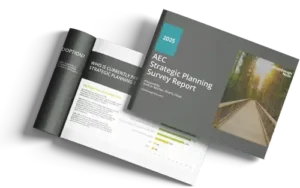What’s Ahead for AEC Firms in 2026: Top Emerging Challenges

“There is nothing permanent except change.” The words of Greek philosopher Heraclitus, spoken more than 2500 years ago, ring true today.
As we look toward the end of another year, and plan for 2026 and beyond, we need to understand the trends and disruptions challenging our firms, our industry, and our clients, then adopt an anticipatory mindset to position our companies for what is to come.
The Persistent Reality of Volatility and Uncertainty
The year 2025 saw tariffs, continued high construction costs, a minor decrease in interest rates, projects placed on hold or cancelled, and a significant change to the DBE certification process. AEC firms face a volatile and uncertain environment.
The Talent Crisis: The Six People-Focused Challenges in the Top 10
When we unveiled the Stambaugh Ness 2025 AEC Industry Outlook last December, Recruitment of New Staff was still top of mind for firms participating in our survey. Eighty-one percent of firms identified this as a moderate or extreme concern, followed closely by the lack of mid-career professionals, which we refer to as The Missing Middle. This challenge was identified by 76% of survey participants.
These are two trends that will not be solved overnight. In fact, we need to look at these trends spanning years—or even decades.
Just look at what we know:
- The US birthrate has generally been in decline since 1960, and those born that year turned 65 this year.
- The current US birthrate is at its lowest ever, and well below the level required to sustain the population.
- Undergraduate enrollment at colleges and universities has increased over the past year; however, it remains 2.4% below pre-pandemic levels—and colleges are just now approaching the “enrollment cliff” due to the declining birth rate.
- Employee tenure in architecture and engineering positions has plummeted since 2012 (from 7.1 years to 4.9 years – a decline of more than 30%)
For firms looking to grow, the challenges of not only finding staff at all levels but also developing them and identifying future leaders have become a major priority. Anecdotally, we’ve talked with firms that have taken more than two years to fill open positions. Certainly, this is related to the type of position, the location of the position, and the company’s employer brand. However, finding, developing, and retaining people are major priorities for firms right now. In fact, our last AEC Industry Outlook found that 72% of firms view the Need to Better Train Staff as a current challenge, while 68% identified Retention of Existing Staff as a concern.
In fact, six of the top 10 challenges identified in the research were specific to talent, with Cost of Benefits and Wage Growth being the additional concerns.
Beyond the Numbers: Understanding the Talent Crisis Drivers
The demographic shifts, declining loyalty, and challenges of “Peak 65” are defining your firm’s future. For an in-depth analysis of the trends driving the AEC talent crisis, read Scott Butcher’s full forecast.
Completing the Top 10: Operational and Economic Challenges
Beyond the talent challenges, here are the others that made the top 10:
- Managing Company Growth [69%]
- Improving Operational Efficiencies [69%]
- Cost of Technology [63%]
- Inflationary Pressures [62%]
As we conduct the latest research to help AEC firms prepare for 2026, will the top 10 change?
Economic Signals: A Mixed Outlook for the Industry
One year ago at this time, 48% of survey participants identified the Ability to Obtain New Projects as a challenge. Still, roughly three-quarters of respondents ranked it as a moderate concern, not an extreme one. Furthermore, heading into 2025, only 10% of our survey participants anticipated a recession—a decrease from 24% the prior year.
However, with the numerous disruptions we’ve seen in recent months, will this optimism persist? Based on what we’re seeing from industry organizations, there is still a general positive outlook, but the data does offer a bit of a mixed bag:
- The American Institute of Architects/Deltek Architecture Billing Index has generally been in decline for three years. Earlier this year, the AIA reported that backlogs had remained consistent at firms, but now a softening of backlogs and general “weak” business conditions are increasingly a concern.
- The American Council of Engineers Companies Business Sentiment Index for the engineering/design services industry scored a +71 in the most recent release – down from +82 the prior quarter, but still very high. Of course, the sentiment for the overall economy was only +11.
- The Associated General Contractors reports that Sales Expectations are up from one year ago, and that although backlogs are down from one year ago (8.9 months), they’ve risen from the prior month and now stand at 8.5 months.
Projected Disruptions and the Rise of AI
In September, Stambaugh Ness released our new 2025 Strategic Planning Survey Report, in which we asked firms about the most impactful disruptions they anticipate in the coming years. Artificial Intelligence ranked first, followed by The Missing Middle, which remains a significant challenge for companies at present. The top 5 disruptions identified in the research include:
- Artificial Intelligence
- Talent Shortage – Mid-Career Level
- Economic Downturn
- Talent Shortage – Senior Level
- Skills Gap – Declining Knowledge of the Workforce
With all the mixed signals in the general economy—and even within the AEC industry—it’s not hard to see why Economic Downturn ranked third. Interestingly, the Talent Shortage – Senior Level ranked fourth, which is somewhat driven by the retirements of Baby Boomers and also by demographics: Generation X is a smaller generation than the Baby Boomers, so there aren’t enough of these professionals to fill the senior roles in our firms. This has created opportunities for the Millennial Generation; however, the Missing Middle trend impacts this, as does the fifth disruption: Skills Gap – Declining Knowledge of the Workforce.
Bridging the Skills Gap and Preparing Future Leaders
We continue to hear from clients that the knowledge level of current employees lags behind that of prior generations at the same point in their careers. Of course, every generation says that about the one that follows. And yet, AEC firms have been so busy in recent years, and with so much talent leaving the workforce, effective mentoring and knowledge sharing are lacking at both large and small firms. Emerging leaders are not receiving the necessary training to lead firms into the future.
What else will the new research tell us?
Accelerate Success: Next Steps to Shape Your Future in AEC
As the industry continues to evolve, data-driven insights are more valuable than ever. Help us capture an accurate snapshot and see where your firm stands among peers.




